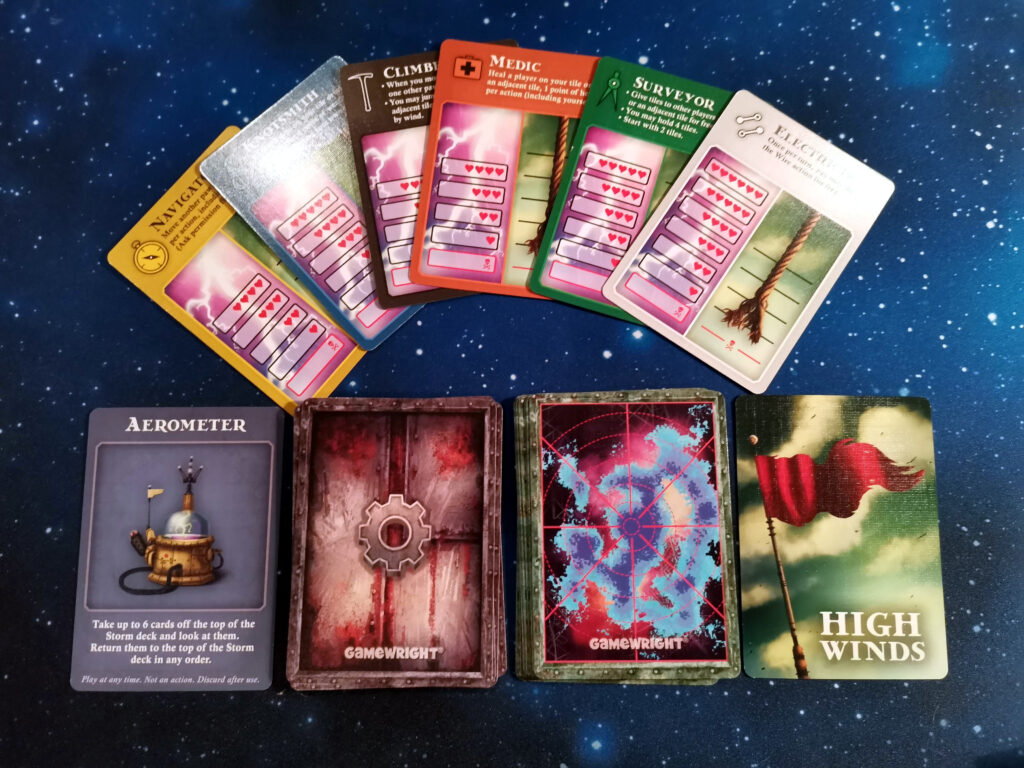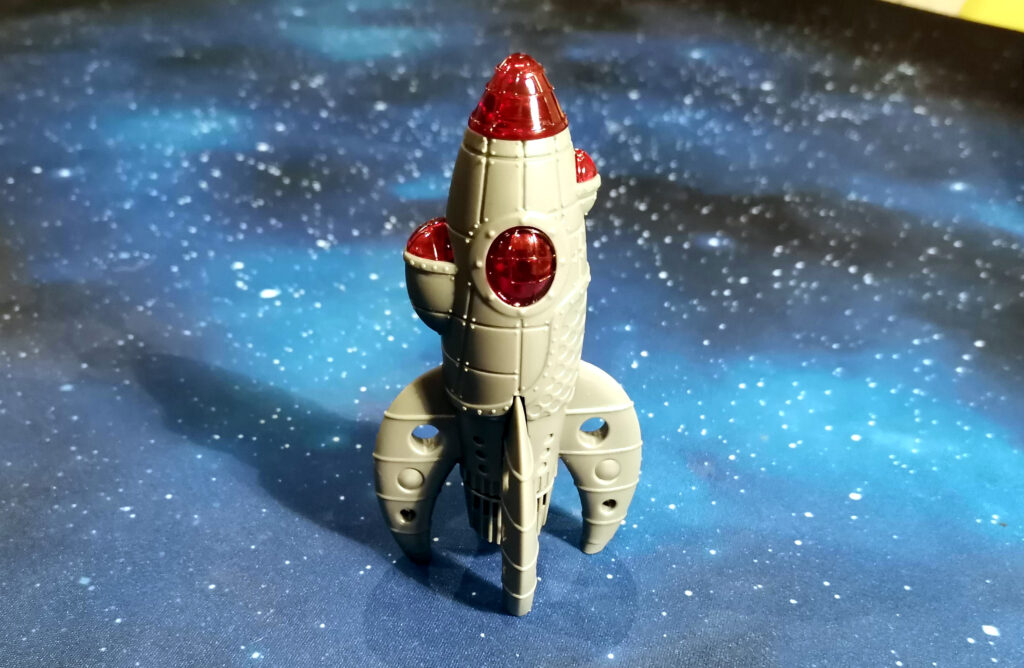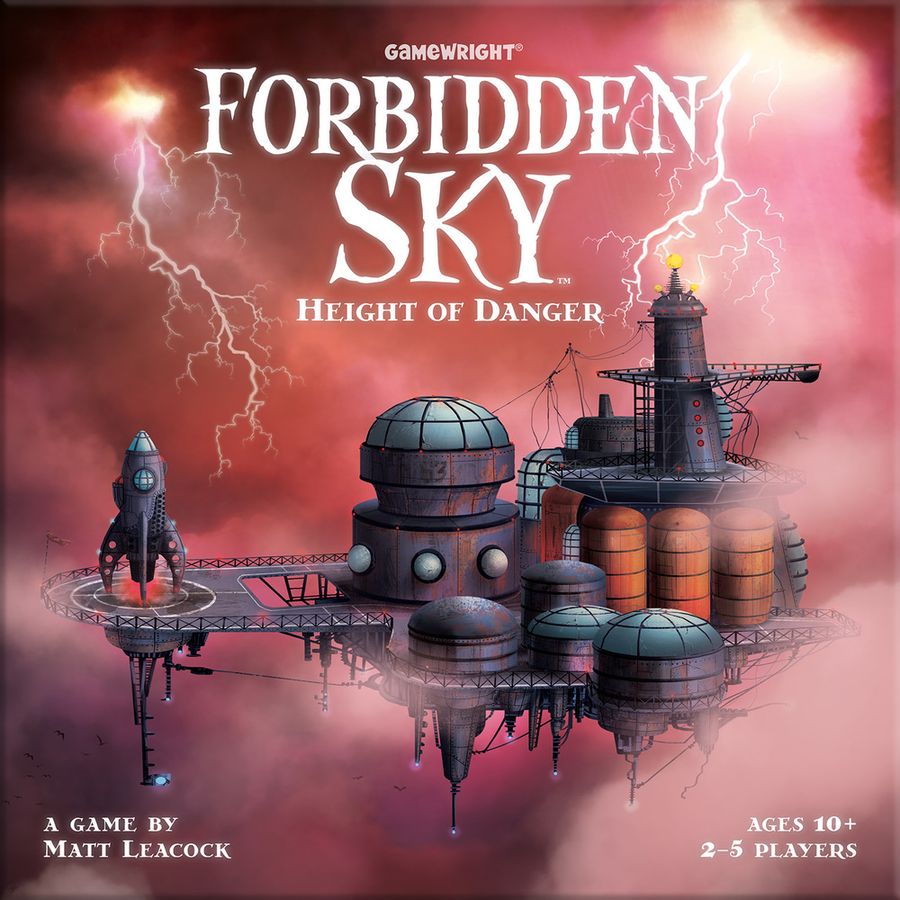Here’s a question for you. How many of your board games use electricity? Not that many I’m willing to bet, but maybe a few favourites from the ’80s and ’90s. Of those, how many of those require you to make an electrical circuit in order to win the game? And how many use that electrical circuit to power the very rocket ship that’s going to fly you, and your intrepid companions, far away from lightning storms and deadly winds, 7,000 feet above the planet? Do I have your attention now? Read on, adventurer, and find out more about Forbidden Sky.
Forbidden Sky is the latest in the ‘Forbidden’ series from Gamewright. The series started with Forbidden Island, the game that comes in a tin that you could even buy in Waterstones. Then we had Forbidden Desert, which was more of the same. Forbidden Sky is the third in the series and makes the move to a big square box, and also shakes things up in some interesting new ways.
Cloud City
In Forbidden Sky, you and your fellow players are all working on the same team. Your flying machine (from the previous game) is landing at a secret platform in the clouds, and you can see a rocket poking through. That rocket would set you on the way in your continuing mission to finding the long-lost civilisation. But to find that rocket you’ll have to work your way through the clouds, building circuitry, avoiding lightning strikes, and trying not to get blown off the edge.

To do this each player assumes a role, each of which has a unique ability. You’ll be flipping tiles to add to the platform, building capacitors and lightning rods, and once you find the launch platform, actually completing an electrical circuit to power the rocket. The longer the game goes on, the worse the storm gets, and you’ll be lucky to finish your work and escape.
Forbidden v2.0
Forbidden Island and Forbidden Desert were very similar to play, so thankfully Forbidden Sky introduces some nice changes. The electrical theme carries over into the game, where you’ll be working to build a working electrical circuit, and it’s really clever. You can add lightning rods and capacitors (plastic discs with metal on top) when you place certain tiles, and one of the actions available lets you add a wire. The wires are plastic, but with a piece of metal underneath. The launch platform has two separate metal tiles on top, the rocket stands on top, and the fins the rocket stands on have metal contacts in. What this all means is when the circuit is complete, with the rocket as the link in the middle, it has flashing lights and sound effects!

I think both mine and my son’s eyes went wide the first time we finished a mission and it started flashing. I’ve not played another game that does anything like this . Immediately after finishing our second game (in a row, no less), when I started to pack it away, my son stopped me. He wanted to take all the pieces and make his own circuits, and was so excited to see how it all works. It immediately turned from a game into a STEM kit. I know this is a game review, but I thought it was important enough to highlight this extra level of enjoyment and discovery that younger players can take from it.
We came for the games!
Okay, okay. Let’s get to the meat of the game. Matt Leacock is the designer, and it’s fair to say he knows his stuff when it comes to co-operative games. You might have heard of a small series of games he designed – Pandemic? Forbidden Sky is a co-op game of exploration, tile-laying and action management. Flip tiles and add them to the platform, add wires, use items, and help out your teammates. It gets more difficult as the game goes along, as a storm tracker slowly increases and demands you flip more cards. It adds a real sense of tension, as the game always builds up to an exciting finale. It’s not a difficult game if you play it at its easiest level, which is perfect when playing with kids. As you get more experienced though, you can easily make the game more difficult by starting the storm tracker at a higher level.

There’s a decent amount of replayability too. There are six characters in the box, each with their own ability to help the team succeed, and the tiles always come out in a random order, as do the storm cards and the items you can collect and use. If you’ve played either of the previous Forbidden titles, the game feels immediately familiar, but different enough to keep things interesting.
Rocketman
I challenge even the most ardently grown-up and mature among you to not go “Ooh, wow!” when you open the box and see the rocket in Forbidden Sky. Rocking that retro-futurism feeling, it looks like the rocket you would have drawn as a kid. You might look at it and think “It’s a gimmick, what’s the point?“, but there’s a really big point here. Make no mistake that this game is aimed at families, and adding what looks like (and is) a big, plastic toy front-and-centre is going to help you engage the younger members of your family. And the bigger kids too…

I speak from personal experience when I tell you that a really big step in getting children younger than ten to engage with board games, is to bridge that divide between toy and game. You and I might get excited by a big box of cardboard and wooden meeples, but younger children want something to play with. Something exciting, and fun. The rocket is exactly what bridges that gap. Literally and figuratively if you count making the electrical circuit.
Summary
I really like this game. It’s light enough that I could teach to anyone, and I think kids from eight-years-old and upwards would be able to play along and make their own decisions, if sometimes with a bit of steer from an adult. If you were playing it with a serious group of gamers, I think it would open itself up to quarterbacking. But it’s not really aimed at the hardcore audience, so it shouldn’t be an issue.
If you’re looking for a game to play with the family that you can learn in five minutes, and play from start to finish in about 45 minutes (allow 15 minutes per player as a guide), Forbidden Sky is a great choice. It’s fun, tense, encourages co-operation, has a cool theme, and everyone wants to make the rocket light up.

Designer: Matt Leacock
Publisher: Gamewright
Art: C. B. Canga
Players: 2-5
Playing time: 45-60 minutes
Review copy kindly provided by Coiledspring Games. Words and opinions are my own.
